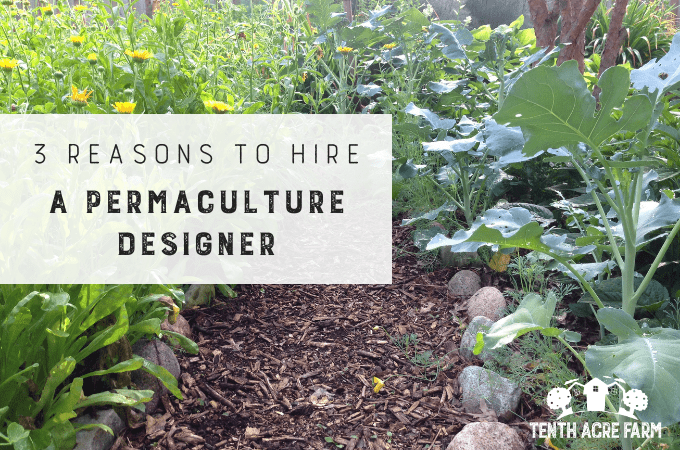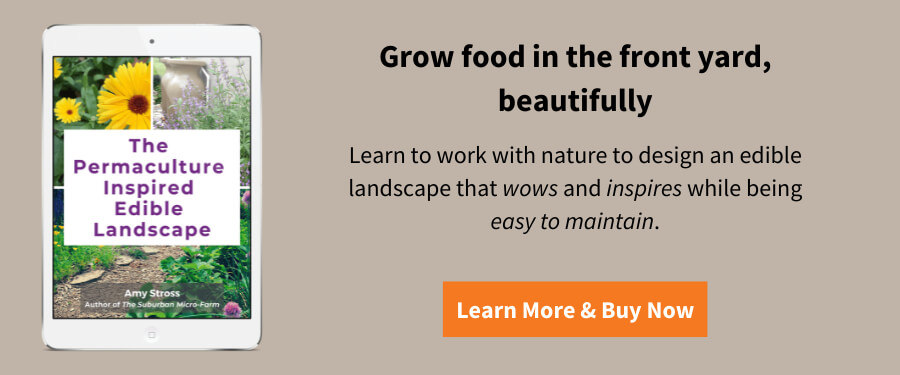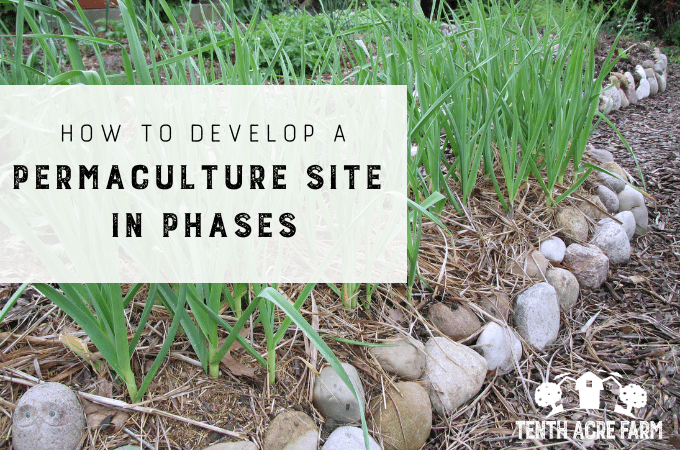Designing your homestead garden can be overwhelming. Here’s how a permaculture designer can help you meet your goals, and what to look for in a designer.

This page may contain affiliate links. Please read my disclosure for more info.
The Homestead Site Design
Having a productive homestead property is an ambition that many strive for. After acquiring your property, however—whether it’s a 0.10-acre in the city, an acre in the suburbs, or 10 acres in the country—the question is: How do you know what components to place where?
For example, how do you figure out where to place the garden, the chicken coop, a meadow, or an orchard?
Productive Permaculture Homesteads
Permaculture is a design science whose focus is on helping you make the best decisions on your site so that you can work with both your goals and the ecology of the land.
In this article, I’ll show you how permaculture designers can help, as well as how to find the right designer/consultant for your needs.
Is hiring a permaculture designer right for you?
In my experience, many people know how to grow their own food, manage livestock, and operate a homestead. Therefore, the biggest challenge is in designing the site so that all the pieces work together as efficiently as possible. In other words, how can you utilize the resources of the land to their full potential?
If you’re interested in a well-designed homestead, then a consultation with a permaculture designer might be right for you. However, if you’re more of a DIY-er, then skip to the end of this article for some ideas on how to get started on your own.

This garden design takes advantage of the slope to capture water for passive irrigation.
The following are three reasons why a permaculture designer can help bring your homestead vision to life.
#1: Permaculture designers can read the landscape.
Permaculture designers are trained to read the landscape and assess a property for its full, productive potential. They notice opportunities to catch and store resources on the land, such as rainwater flows or fertility. In addition, they can group components together to maximize their efficiency.
For example, the vegetable garden and chicken coop may be grouped together because you visit them everyday, and they exchange resources. You might regularly take weeds and plant matter from the garden to feed the chickens. Likewise, chicken waste turns into a rich soil amendment for the garden.
A permaculture designer looks for ways to have the greatest effect for the least amount of work.
#2: Permaculture designers can facilitate your vision.
Permaculture designers can help craft your vision into something that is fun, rewarding, and possible. There’s nothing worse than having a vision in your head and not having the tools to implement it to its full potential!
Self-directed homesteaders can read up on permaculture techniques such as swales, food forests, and herb spirals, etc. However, it’s often difficult to find the most useful and efficient placement of these components on the land.
Additionally, each household has its own goals. Perhaps a large garden isn’t on your wish list, but a wildlife corridor, bird sanctuary, or backyard forest retreat is more your style. A permaculture designer can help with your vision.
No matter your desired theme, a designer can help you tweak your site plan so that it is realistic and do-able, dividing the work into implementation phases, if necessary.
In fact, there’s no shame in seeking a consultation from a profession. Even professional and experienced designers seek advice from peers because, as the saying goes, two heads working together usually produces a much more robust solution.
One homesteader, who worked with a permaculture designer to design his property, had this to say: “…if you have NO experience, and you have some extra money like I did I think you would shave YEARS off of your learning curve.”
Create Your Own Individualized Permaculture Design (with me by your side)!
Tired of generic permaculture design advice that you can’t apply to your specific goals?If so, check out myPermaculture Design Program and get the step-by-step tools and support needed to create and implement your own permaculture design.
#3: Permaculture designers can work with challenging sites.
A permaculture designer can help improve the stability and ecology of challenging conditions such as steep hills, drainage and erosion issues, poor fertility, or damaged wildlife corridors.
Using nature as the instruction book, a trained designer can help you balance a productive landscape with ecological repair.
8 Things to Look for in a Permaculture Designer
The following concepts will help you find the right expert for you. You can often find this information on the professional’s website, and if not, don’t be afraid to ask for it. They’ll be pleased that you’re doing your homework to seek out a designer who is aligned with your goals.
#1: Education
Permaculture designers should have completed the 72-hour permaculture design certification at a minimum, which demonstrates their commitment to the permaculture design process. Often you’ll find landscape design consultants who’ve added permaculture design certification to their professional repertoire.

A kitchen garden is placed right outside the kitchen door for easy access.
#2: A Permaculture Designer’s Level of Experience
Look for indicators of relevant experience. If your property is rural, do they have experience working with rural properties? If cost is a concern, new designers often consult at a reduced fee in order to gain experience and build a portfolio.
#3: Insurance
As a professional service provider, the designer should be insured. They may be bonded as well, which means you’ll be compensated in the event that the agreed upon work isn’t completed.
#4: A Good Permaculture Designer is a Good Communicator
A good consultant communicates how their design process works up front as well as the fee structure for the services.
They also have a method for determining whether their services are a good fit for you. Often this is through a questionnaire or initial interview. After meeting with you, the designer can clearly define what a successful project looks like from your point of view.
#5: Scope of Work
Be clear about what you’re looking for. Do you want:
- A site plan that you can implement yourself?
- A site plan that includes installation?
- A planting plan for a defined area?
State your expectations clearly, and look for feedback from the designer that they’re willing to work within these parameters.
Additionally, are you looking for ongoing maintenance of the completed design? If so, is this a service the designer provides?

A master site design for my new homestead.
Want to grow fruits, vegetables, and herbs in your front yard landscape without sacrificing curb appeal? Check out my mini guide, The Permaculture Inspired Edible Landscape.
#6: Ask To See a Permaculture Designer’s References
Ask for client references, testimonials, and/or a portfolio of previous work. What are others saying about the designer? How do you feel about the quality and style of the work displayed in their portfolio?
Strike up a conversation to hear stories about previous projects and whether they talk favorably of previous clients.
Can the designer talk gracefully about how they overcame challenges, be they design or communicative challenges?
#7: Written Contract
The designer should present you with a professional, written contract. It should include the agreed-upon scope of work, as well as the expectations of both parties.
#8: Compatibility: Is the permaculture designer a good match for you and your goals?
This goes for hiring any service provider: You should like the professional as a person. Did you feel comfortable interacting with him or her? After all, you’ll work closely together over many meetings, so be sure your demeanors are a match and you find them to be professional, knowledgeable, and trustworthy.
Ask the Expert: Traits of a Good Permaculture Designer
I recently connected with my friend John Hemmerle, Owner and Designer of Our Land Organics about this topic. John is a knowledgeable and dependable expert. He and I received our permaculture design certificates together, and I often hire his team to do work on my site.
I asked John what he thought the most important traits were of a good permaculture consultant. Here are his tips:
- A good designer has good communication and project management skills.
- The design process, fee structure, and written contract are clearly defined.
- They’re a good listener, helping the client to clarify their vision and to define what success looks like.
- The designer insists on managing the installation in order to ensure the client’s vision is implemented as agreed upon. The success of a landscape greatly depends on how well it is installed.
More importantly, John thinks that finding the right designer comes down to making sure the designer’s expertise matches your goals.
The Site Consultation
All of John’s new clients fill out a landscape analysis questionnaire before the in-person consultation. This determines whether his services are a good fit. It also gives him an idea of the client’s goals.
The design consultation is an opportunity to meet in person, walk the property together, and discuss the clients’ wildest dreams. He draws up a consultation summary, which includes recommendations and ideas.
John and the client then decide if continuing to work together to create a design makes sense.
The Design Process
The next step for John’s clients is a 3-meeting design process. This in-depth design framework includes a conceptual design phase, a preliminary design phase, and a final design phase. Designing is an iterative process that allows for observation, exploration, and revision.
Throughout the design process there is ample room for feedback and revisions, which leaves little room for surprises during the final design presentation.
The conceptual design includes an analysis and survey of the land to more accurately define the property’s potential. This is the phase in which to experiment with the placement of various components in the design.
The preliminary design takes feedback from the conceptual design and includes specific plant and materials lists. It also includes cost estimations and implementation phases. He presents the preliminary design to the client and again takes their feedback into account.
John presents the final design to the client, and once he has their approval, he reserves an installation date. A written contract then clearly defines the scope of work, timelines, and service fees.
As a consultant, I’ve found it especially informative to learn Our Land Organics’ custom design process for creating amazing designs that meet the client’s needs while developing the ecological health of the site.

Conceptual Design Example by Our Land Organics
Permaculture designers are facilitators, illustrators, and educators.
Beginning with the end in sight, they listen to the needs and visions of the client and balance them with the needs of the property. Like any professional, you’re paying them for their years of experience and training so you can save time, avoid costly mistakes, and feel confident it’s being done the right way.
You’re also going to learn a lot. Most designers are passionate about what they do and want to spread their knowledge. Above all, there is the added reassurance that you’ll end up with a design you are happy with. Peace of mind is a great thing.
Summary
As you can see, a permaculture designer can remove the overwhelm by helping you read the landscape and create an efficient and productive site layout that matches your vision.
Have you received assistance from a permaculture designer on your property?
For the DIY-ers
If hiring a consultant isn’t for you, but you want to take steps toward being your own designer, here are some pointers.
First, observation is an essential starting point in the permaculture design process.
Learn how to use the power of observation (and get my free, 13-page worksheet to help). Then, you’ll want to make active observations by by collecting data about your site and plotting it on physical maps of the property. This gives you a visual representation of all the data points that can affect design decisions.
After that, learn how to develop your permaculture site in phases.
Want to join a course? Here are some options:
- Complete an official, 72-hour permaculture design certification. Here are my tips on how to choose a course.
- Sign up for my free, 10-day mini permaculture course.
- Enroll in my Permaculture Design Program and learn to confidently design your own site with me by your side.
Then, hone your knowledge and skills by apprenticing with experienced designers, and practice, practice, practice.
Books to check out:
- Permaculture Design: A Step-by-Step Approach
- Practical Permaculture for Home Landscapes, Your Community, and the Whole Earth
- The Resilient Farm and Homestead: An Innovative Permaculture and Whole Systems Design Approach
READ NEXT:








Melissa says
Brilliant post! I know that when we find our Forever Homestead, it will important to be intentional about how we design our needs around our land. Being in the high desert poses it’s own unique challenges and i think that hiring a consultant to get us started is a very good idea! Thank you for all the information you shared here 🙂
Amy says
Best of luck in your search for a Forever Homestead along with all of the excitement and challenges that come with it. I hope you’ll find a consultant who can help you create an amazing design in your climate 🙂
Mandi says
Very good info! I’m definitely going to check into this and see if there is anyone in our area.
I’m coming over from the Homestead Blog Hop!
Toni says
Amy, this is a really well-written, well-put together article. If you haven’t already, you should really consider submitting it to Mother Earth News, or another gardening/homestead magazine….
Amy says
Thanks for the encouragement 🙂
Amanda says
So interesting! The hubby and I are making a lot of changes to our property to turn it into a homestead. Getting advise from an expert would be wonderful! Thanks for sharing on the Homestead Blog Hop!
Ginger says
Hi Amy,
Larry and his son Elijah came last week, and it was so enjoyable that I didn’t mind writing the check for the consult $$$$.
Thanks for the recommendation and I will keep you posted on what happens when we get started.
Blessings,
Ginger
Amy says
That makes me so happy! I can’t wait to hear more as your design develops!
Jen says
Hi, Amy. I love your blog. 🙂
I am just wondering if you could give me some advice. I think I am really interested in taking the PDC course, but I am not sure it would be a wise financial decision for me.
I think I would get a great deal of fulfillment out of this type of work. However, I would need to learn a lot and would have no experience with a completely integrated permaculture design. (I read your other posts about how simply using some permaculture principles won’t work. I can attest to that!) I’ve read permaculture books, but I still know next to nothing. I feel as if I’m missing an important link that will make everything click. That link is probably hands-on experience and formal training.
I’m afraid to invest in the whole course, however, if it wouldn’t at least bring a return on the initial investment. Do you have many clients? Are there additional ways that you can offset your costs? Do you typically work with someone as you are gaining experience?
In some ways, I think the course would be a huge benefit simply for our own homestead, but again, I’m afraid to plunge in head first! I would love to hear your thoughts.
Amy says
Great questions, Jen. There is no right answer here, but here are my thoughts:
If you’re interested in designing professionally, you’ll need two things: a PDC (permaculture design certificate) and a portfolio, i.e. experience.
I spent five years participating in public permaculture projects in my community, doing side projects at friends’ houses, and developing my own property, before professionally designing for others. I’m not suggesting that you need to spend as much time as me doing volunteer/free projects, but the more time you spend working on projects, the better you’ll be as a designer. Practice makes perfect, as they say.
I still consider myself a student more than an expert, but I feel confident that I can now provide quality designs for clients. That’s because if I’m challenged by a particular site, I have a network of permaculturists I can tap for ideas, so the free projects and taking the PDC paid off in more than one way. In fact, the design work I do is in collaboration with my buddy John of Our Land Organics, who took the PDC class with me in 2009.
Professionally, the PDC is worth it and necessary, but so is experience, so I wouldn’t consider quitting my job and going all in. It will take some time to learn and gain experience before going into business would be possible.
Education is my main source of income rather than design. However, everyone will use their permaculture training differently depending on their interests, strengths, and personality.
As for studying permaculture for the sole purpose of developing your own property, a PDC is less necessary, though still useful. In my area, there have been hands-on classes taught on reading the landscape for water flow and constructing swales, as well as workshops where food forests were installed. These classes would have a profound benefit to the homeowner, so look for hands-on workshops. The PDC is less hands-on and more focused on theory.
I hope that helps!
Jen says
It does help! Thanks.
I think I am leaning more and more towards taking the course. I think first, I may need to connect more with others who might be able to help me learn. Can I ask how you found workshops like the ones you mentioned about constructing swales and reading the landscape? I have attended some workshops in the area, but they seem to be more introductory type things like planting pollinator gardens and things like that- still very useful and great workshops, but more topical in nature.
Thanks again for your response! I appreciate it!
Amy says
If there are permaculture organizations or permaculture meet-up groups in your area, it would be a good idea to get on their newsletter lists so you find out when hands-on workshops come up. They also might be able to point you to workshops in your region.
There isn’t a great one-stop source for finding workshops around the country/world. Permaculture Activist magazine and Permaculture Magazine might be two places to check for opportunities outside of your area.
Good luck!
Elle says
Hi Amy, I was wondering what range of prices one should expect to pay for a consultation or design services from a permaculture expert? Thank you.
Amy says
Hi there. I purposely didn’t list any prices because they will vary so widely. Designers just starting out might do a consultation for free, others might charge up to $200 for a 1-2 hour consultation that would include follow-up notes and recommendations. Drawing up designs is a little more complex (more $) and will also vary widely, depending on the size of the space and the goals of the homeowner. And then there’s installation if you want it.
The best bet is to contact several people and ask. They should be willing to tell you their price range up front. I’m always honest with a service provider if their prices are more than I can afford (“Thanks so much for talking with me. That is a little over my budget right now–I’m aiming to spend more like $____, but I’ll keep you/your company in mind for the future.”) Sometimes they’ll work with you if what you can afford isn’t too far off.
Go with a consultation first and be sure you like the person before going forward with design and installation.
Elle says
Thanks so much for your response Amy. That’s very helpful. I will keep all that in mind when I’m doing my research. Thanks for all you do on your website & sharing! 😉
Amy says
Glad to share! I hope you have a great permaculture experience 🙂
Nancy says
How do you go about finding a professional permaculture consultant? We recently bought property in South Dakota and I have not been able to find a permaculture consultant in the area.
Amy says
I don’t have any personal connections in South Dakota, but when I google, “South Dakota permaculture”, a lot of interesting things come up. I recommend contacting any permaculture organization or group you can find, as they may know someone or have trained someone in your area.
You may also find some helpful tips in my article How to Choose the Right Permaculture Class.
Congrats and good luck on your new property 🙂
Ken says
I would be very glad if you could advise on some permaculture designers with experience and interest in permaculture in the tropics. I have a 17 acre property in Uganda that I need help with to be commercially productive based on a permaculture model.
Gabriel says
Nice article! I have 45 years experience designing and helping build eco communities, farms, gardens, pools (likely about a thousand swimming pool projects in many states), greenhouses for microgreen/wheatgrass/veggie production, orchards, homesteads,etc. On our team we have myself (experience includes 21 years as a licensed landscape contractor in Oregon with a certified environmental business there), architect, chef, 2 permaculture farmers, certified food producer, graphic designer (comes in handy if we are developing a brand for a farm), a second graphic designer from Mexico with a masters in sustainability.
The idea with our team is to help people find land, develop their plans and be involved through the construction and operational phases. Especially if it is a farm to table restaurant then our chef can work and help develop the menu and kitchen facilities until the restaurant is running well. We are based in North County San Diego but collectively have worked in many states and at least seven other countries which includes Central America and South Africa.
Reading the comments here it is great to see so much interest in permaculture, The ecology, The overall well-being of our planet that we all share.
GG says
Wow. I’m in Alabama. North Alabama. 12 miles from Tennessee. Would be grateful for permaculture farmer consultation, on site, for my steep hill leading down to cliff over a very large, fast moving creek. Years ago I built a deck as close to the creek as I could get and placed a yurt on the deck. About a half acre surrounding the yurt has been planted year to year in various areas with flowers and vegetables. A few fruit trees and a grape vine are in the mix. The cost for such help is most likely prohibitive.
For years I drooled over Geoff Lawton’s recordings of his permaculture miracles in Australia, I think it was. The yurt sits on this steep hill which is part of 200 acres of rolling pastures surrounded by wooded forest, bordering about 2 1/2 miles on the same creek the yurt sits over-looking. Wonderful to read about what you’re doing to promote permaculture.
Steve Speakman says
Hi, can you recommend a designer in Southern CA?
I subscribe to your newsletter and have purchased your book, The Suburban Micro-Farm.
Thank you.